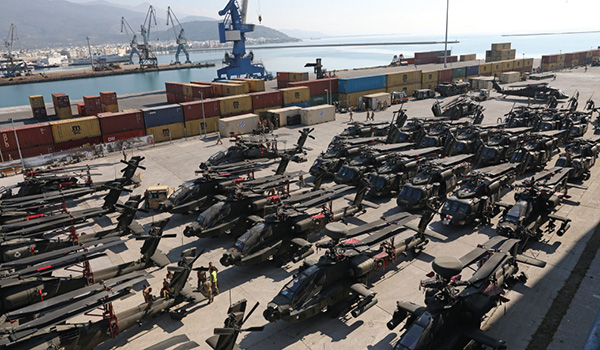
Maintenance / By CW5 Michael D. Cavaco: The Stubby Pencil Maintenance Burden. We’ve all been there… Showtime three hours prior to takeoff, crank to meet commo check, takeoff at noon for a five-hour mission, hit the FARP, and back to the house – mission complete. Or is it?

AH-64 Apache helicopters from 3rd Combat Aviation Brigade, 3rd Infantry Division, await to be reassembled October 27, 2019, in Volos, Greece. 3-CAB is arriving in Europe in support of Atlantic Resolve to conduct bilateral, joint, and multinational training. / U.S. ARMY PHOTO BY SPC ELLIOTT PAGE, 21ST THEATER SUSTAINMENT CMD
The chances are pretty high in that scenario that a 1200 takeoff and engine shutdown at 1722 got logged as 5.5 flight hours. We’ve all heard the excuses – “The FAA starts the clock when the engine starts, so I’m getting credit where it’s due” or “Close enough for government work.” But they’re just that… excuses. But does that extra two-tenths of an hour really matter?
The short answer is yes. The tendency might be to think that rounding occurs in both directions and cancels each other out, but that is decidedly not the case.
In an effort to capture the difference between actual flight time recorded by onboard systems and flight time logged by aircrews, AMCOM studied actual ULLS-A aircrew flight logs (DA Form 2408-12) and compared them to UH-60 Health and Usage Monitoring Systems (HUMS) over the course of a year in 2006. HUMS flight data was tracked using rotor speed (>95%), Weight-on-wheels switch (in flight), combined torque (>40%) and radar altitude (>5 feet).
Recorded vs. Logged
Right out of the gate, there were some very interesting findings – remarkably, 45% of all flights ended on the hour or the half hour. More importantly, the study determined that HUMS recorded 15,945.6 flight hours across four units, two deployed and two in garrison. However, the 2408-12s for the same flights totaled 18,541.4 flight hours. That’s a difference of 2,595.8 flight hours – hours that were logged, but not flown – or six extra (unnecessary) phases per year. Put another way, eliminating that difference also eliminates the following for a CAB: 88 inspections, 116 unavailable days, over 2,000 maintenance man-hours, and saves approximately $2.9M in flying hour funding.
The obvious result is that aircrews are logging approximately 16% more flight time than the aircraft is recording. By and large, this is done without malice, but the result is the same – increased maintenance burden. At a time when the demand for Army aviation support remains as high as ever, we can ill afford to accommodate recreational maintenance. It is imperative that we decrease this maintenance burden – consider it a “War on –M time.” There are multiple ways we can tackle this issue, most notably by completely re-addressing the scheduled maintenance program of all our airframes to make sure we are accomplishing the right task at the right time. This will take time and effort, but part and parcel to all of it is accurately capturing the operating hours on all the dynamic components and subsystems. In order to do that, we need to take the “stubby pencil” out of the equation.
Removing the Stubby Pencil
So, how do we do that? Our modernized fleet all have some sort of health monitoring system that records the operation of the aircraft and its systems. And the data captured by these systems is the absolute most accurate way to compute flight time. Whether via the Black Hawk IVHMS, the Apache MDR, or the Chinook CPHE, we can capture this data post-flight to populate the flight pack (specifically, the DA Form 2408-13). Bottom line, the aircraft knows exactly what it flew, so why don’t we let the aircraft tell us when we need to perform scheduled maintenance? It makes sense, and it’s coming… and sooner rather than later.
There is currently an EXORD in staffing that will direct automated flight time reporting via aircraft systems. So, re-imagine the scenario from the beginning of this article. This time, end the scenario with “back to the house, MDR download, fill out the book, and then mission complete.” It’s not far-fetched, and there’s no good reason NOT to do it. There are still some details to be worked out regarding the daily execution of this task, particularly for those aircraft yet to be fielded with HUMS systems, but the savings in unnecessary maintenance leads to increased aircraft availability, and, ultimately, more flight time available for everybody.
Automated flight recording is just one small piece of Conditions-Based-Maintenance (CBM), but it’s the foundation for getting our scheduled maintenance right. We MUST continue to press forward to make sure all our aircraft and logistics information systems can capture each flight hour to the second. We simply can’t afford not to.
CW5 Michael D. Cavaco is the Aviation Branch Maintenance Officer, U.S. Army Aviation and Missile Command at Redstone Arsenal, AL.










